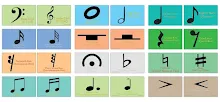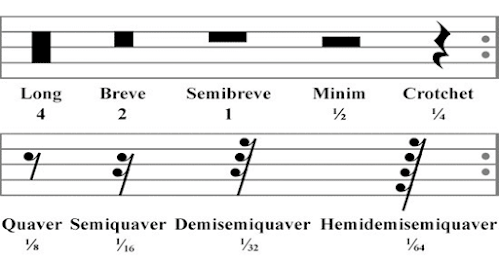
Musical notes are written in symbols or easily distinguishable marks. The musical notes have a pitch, duration, and intensity. It is beneficial to have knowledge about these marks. The meaning of music symbols is given in this article.
The mnemonics “Every Good Boy Does Fine” and “All Cows Eat Grass,”
helps kids memorize the notes on the lines of the treble clef and the spaces of
the bass clef, respectively.
Sheet music or music notation employs a series of symbols and
marks that pertain to certain notes, pitches, and tones. Music notations are
visually represented symbols, which often include both modern and ancient
musical symbols.
Modern
music notation is commonly used by musicians of different genres throughout the
world and is said to have its origins in European classical music. This popular
system uses a five-line staff to place the musical notes. Sheet music used is as a
record or a guide to perform or compose a piece of music.
To
be able to read this sheet music, one has to study the musical notations, for
which, one has to be acquainted with the symbols used to represent the notes.
Below is a list of the musical symbols employed to write sheet
music:
The staff (or music stave as it is
also called) is the series of 5 lines and 4 spaces that music is written down
on. Music notation developed from one single line, used in the early days of
writing down church chants. The first person to come up with the idea of
writing music down on a line was Guido of Arezzo who was a Benedictine monk and
singing teacher who became famous across North Italy for the speed at which he
managed to teach students to sing chants. He also invented the doh-re-me system,
although it was called ut-re-me when he first developed it.
The terms music staff and music
stave are interchangeable. Staff tends to be the American usage and Stave
tends to be the British usage. I shall use staff on this site.
Ledger or leger lines extend the
staff to pitches that fall below it. It is a short line added above or below
the staff. Ledger lines are generally placed behind note heads and are spaced
at the same distance as the lines of the staff. A range of notes that go beyond
the two staff is put on extra short lines or between the spaces formed
between them.
Vertical lines called bars are
used to connect the upper and lower staffs of the grand staff. The vertical
bars are used to divide the staff into measures.

A
single bar line is used to separate a measure. Each bar or measure refers to a
segment of time that is defined by a given number of beats and note values. To
make it easier to understand, the term bar refers only to the vertical line, while the
term measure refers to the beats that are contained between two bars.
A double
barline is used to separate two sections of music. A double
bar line is also used to signify changes in the key signature, time signature, or
major changes in style and tempo. A dotted bar is used to subdivide long
measures of a complex meter into shorter segments.
A bold double bar or the end line is used to indicate the end of a
movement in a piece of music. It is used to signify the end of an entire
composition.
A bracket is generally used to
indicate the connection between the staff of two or more separate instruments.
To say the least, it is used to connect two or more lines of music that are to
be played simultaneously by multiple instruments.
The
brace on the other hand connects two or more lines of music played
simultaneously by a single instrument. Also called an accolade,
the brace connects multiple parts for a single instrument (the right and
left-hand stave of a piano―for instance is connected using a brace).

The stave, essentially, is mere
lines; however, the presence of the clef marking the beginning of the stave is
what assigns a certain pitch to the notes. The clef, in other words, helps to
accurately relate to the pitch of the musical note placed on or between
specific lines on the stave. In short, a clef is used to fix the position of
certain high and low notes on the stave.
G Clef or the Treble Clef
Originally
resembling the capital letter ‘G’, the treble clef fixes the second line as the
note G on the stave. The treble clef denotes the high notes on the stave and
is commonly used for most modern vocal music.
F Clef or the Bass Clef
The bass clef fixes the fourth line as the note ‘F’ on the bass
stave. The two dots placed above and below the fourth line from the bottom of
the staff is the pitch F. Specifically used in choral music, the bass clef represents
the bass and baritone voices.
C Clef or Alto and Tenor
Clef
The alto and tenor clef fixes the third line on the stave as the
middle C. In modern notation, it is used for the viola and is often used when
composing music using the bassoon, cello, trombone, and double bass. It is a
movable clef, and when it points to the fourth line, it is called a tenor clef.

Octave Clef
The octave clef is nothing but a
modified version of either the treble or the bass clef. The number 8 or 15 is
affixed either to the top or bottom of the clef to raise or lower the intended
pitch by one or two octaves, respectively. Generally, you will find a treble
clef with an eight below in notes written for the guitar and the octave
mandolin.

Tablature
Used specifically for stringed
instruments, the tablature or Tab is often written instead of a clef. Like the
neutral clef, the Tab clef is not a true clef, but a mere symbol used instead
of a clef. Tablature generally involves writing notes on six lines when writing
notes for a regular six-string guitar.

Neutral Clef
The neutral clef is used while
composing musical notes for non-pitched percussion instruments like drums and
cymbals. It is simply used as a convention to indicate that the lines and
spaces on the stave are assigned to a percussion instrument with no precise
pitch. Generally, it is not a compulsion for the neutral clef to be placed on a
regular five-stave, it can be placed on a single stave or line.
Notes represent the length of time
of a particular pitch. Each note stands for a particular number of beats. In
written music, the length of a note is shown by its shape. When there is no
note sounding, a rest is written, and the duration is shown by its shape. To make things easier, we
have classified notes on the basis of their relationship with the whole note or a
semi-breve.
Whole Note or Semibreve
A hollow oval note head represents
a whole note or a semibreve. The length of a full note is equivalent to four
beats in a 4/4 time. A whole note receives 4 counts, which means, you have to
hold the note for its full value.
A whole rest corresponds to a
whole note, which means, the rest period is equivalent to the duration of the
musical note. A whole rest is denoted by a filled-in rectangle hanging under
the second line from the top of the staff.














No comments:
Post a Comment